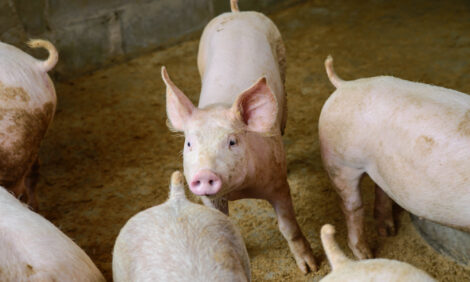



Pork Commentary: European Breeding Herd Plummets
GLOBAL - The significant fall in inventories of the EU's 27 countries is good news for all of Europe and North America's hog producers, writes Jim Long, Presicent and CEO of Genuses Genetics.European Union Pig Inventory, December 2008
Last week, Eurostat officials released a comprehensive inventory of the European Union's sows and market hogs. The good news for all of Europe and North America's hog producers is the huge drop in inventories of the EU's 27 countries.
The European Union 27 country sow inventory has dropped about one million sows in the last year and 1.6 million in the last two years – a huge liquidation (10.3 per cent). This decrease of sows is greater than Canada's entire sow inventory.
EU's total pig inventory is down approximately 7 million pigs from December 2007 to December 2008. That would be about 280,000 less market hogs a week on average year over year. It's a lot and will help push market prices higher. Last week for example, Poland's slaughter price was 66 cents US per lb.
EU-27 hog supplies means less pork tonnage for EU exports, whether it be Japan Korea, Russia, etc. Also, Europe market prices of approximately 66 cents US per lb will give US, Canada and Brazil huge price competitiveness in export markets.
The EU-27 country inventory was counted in December. Our sources in Europe indicate there has been continued liquidation since then. Higher global feed prices over the last 2 years and financial losses have devastated livestock inventories in Europe and the rest of the world. Total meat availability is decreasing. Fewer hogs in Europe helps everyone's hog prices.
| EU-27 pig inventory (December 2008; millions) |
||||
|---|---|---|---|---|
| 2006 | 2007 | 2008 | 2008 as % of 2006 | |
| Sows | 15.569 | 14.904 | 13.977 | -10.3 |
| Total all pigs | 161.929 | 159.724 | 152.975 | -5.5 |
Other Observations
- USDA Pork Cutouts have gained 5 cents per pound. In the last two weeks, packers have restored their margins. Cut-outs of 60.80 and Iowa-Minnesota Lean Hog Price of 55.22 give them a spread that is profitable especially when you consider good future processing margins.
- Weekly hog marketings are falling in line with expectations. The US last week had 2.115 million, with 2.303 million a year ago – about 150,000 less (-6 per cent). We expect the trend line will be about 150,000 head fewer a week year over year during the next three months. Weeks upon weeks of such a large year over year decrease coupled with less beef and poultry is why we remain bullish on huge upside to the lean hog price. In May, we expect US weekly marketings to be below 1.9 million a week – 250,000 head less than now. That's when we will find out how much packers want hogs.
| US February Month-End Cold Storage (thousand lbs) |
|||
|---|---|---|---|
| 2008 | 2009 | 2009 as % of 2008 | |
| Beef | 436.5 | 434.2 | 99.5 |
| Pork | 611.8 | 636.6 | 104.0 |
| Chicken | 760.8 | 647.5 | 85.1 |
| Turkey | 416.7 | 470.1 | 112.8 |
| Total poultry & meat | 2225.8 | 2188.4 | 98.3 |
- US pork in storage is up 25 million pounds year over year. Total poultry and meat in storage is about 40 million pounds less than a year ago. The US is producing around 1.9 million pounds of meat and poultry per week. Total poultry and meat in storage is about 8 days worth of US production, or just over 2 per cent of the US annual production. We believe storage levels show that demand is good and indicates that owners of cold storage product believe that prices of meats will get stronger. You don't keep inventory if you think the price is going lower!
- Sow slaughter numbers are down. USDA sow prices over the last four weeks show an average price of 54.20, while a year ago the same 4 weeks was 26.25 - a difference of about $100 per sow. This sure is an indication that despite a recession when supplies are decreased, demand is such that prices can accelerate.
Three points:- Sausages are not a cheap food. Demand is strong.
- With sows at 54.20, a producer can sell their sows and replace them with gilts even up. There has never been a better hog market price to sow price ratio to improve your genetics and herd health.
- As market hog numbers continue to decrease the sow price explosion year over year a harbinger of what's going to happen to market hog prices? You know that's what we believe.
- Big Sky Farms update. We have had no denial from either Big Sky Farms or the Saskatchewan Government about their 70 per cent ownership of this 50,000-head sow system (half of the province's production). No one has denied the government owned farm is eligible for a $20 per market hog subsidy put in place by the government that owns them. Neither Big Sky nor the government denies that $20 per head when you have 50,000 sows is a huge payout. Do your own arithmetic. The Big Question: how much of taxpayer's money is Big Sky losing every week? How much has the Saskatchewan government given, guaranteed and subsidized Big Sky? The largest government-owned hog farm in the world now that former communist countries privatised. You have to give it to the Saskatchewan government: they have as the chairman of Big Sky, an economist, Dr Larry Martin from Ontario, a former university professor. Unfortunately, it appears that having an economist as a chairman gives no guarantee of success. Does Dr Martin, an ag-economist, believe governments should own hog farms? Does he support this as he took the job as chairman? Is this free enterprise? Governments should not be hog farmers. It's wrong for them to compete with independent producers by using their tax payer money to prop up their inefficiencies. Big Sky, close the doors.
- Ontario Pork-Producers Marketing Board's plans to bring the Ontario Hog Producers hog marketing monopoly into the 21st century were put on hold last week. The 10 million dollar a year funded bureaucracy clings to the hope of job retention. Chairman Curtis Littlejohn teeters between supporting reform and the status quo, mostly status quo. The rumour that he wants to be the Hugo Chavez of the swine industry and stay on at next week's annual meeting will not go away. Curtis, you've had your time. Don't run again. You have been the captain of this bureaucratic nightmare, delivering during your tenure the lowest hog price in the world.
Hopefully soon, the government officials who oversee the legal powers that have given this lame organization monopoly powers with get on with the job and free producers to sell hogs to whomever they wish. How novel! How radical! - Data was released last week that indicate US Pork Exports held in January. A decrease of 4 per cent in volume (2478 million pounds) but were up 2 per cent in value at 295.8 million. We keep hearing from some pundits about the collapse of pork exports due to global recession. We have believed exports would hold, why? Global hog price points such as Mexico 65 cents US per lb, Australia US$1.10 lean per lb, Korea US$1.30 lean per lb, Japan US$2.00 lean per lb, EU 65 cents US per lb live, Russia US$1.10 lean per lb. Point is, every country that buys US pork have high domestic hog prices. It doesn't take a lot of business savy to buy hogs for 55 cents lean in the US and hit a price point competitive with these other countries' prices. Why would exports drop? Another consideration is every one of these countries' consumers are paying more for pork than US consumers. US consumers have more money to spend than the consumers in these other countries. It's also why we believe that as hog supply collapses in May and June that US consumers will continue to buy at higher prices.
- Merle in Nebraska tells us we'd all better get a gun. There is going to be so few hogs in the country in the coming months that the price of hogs will be so high that we'll all have to protect our hog barns against theft. Merle could be right. In Russia, we saw armed security at all the barns. Hogs were US$300 per head. Let's hope hog prices are such that this is our biggest problem.
- A week ago we wrote that in Washington the only US Federal Government building we saw working on the weekend was where they print money. Low and behold, President Obama announced on Wednesday a plan to print over a trillion more dollars. A trillion. That as they say in Washington, will buy a lot of pork. This will be inflationary. It will also support higher commodity prices, including hogs. A lower US dollar supports exports.
Conclusions
- European Union 27 countries down 1.6 million sows from two years ago and 7 million market hogs less than a year ago.
- US hog marketings were down 150,000 last week from a year ago. Fewer hogs always support prices. Last March, the average lean price was 54 cents, the May average was 79 cents. Fewer hogs has always led to higher prices, always will. This May will have fewer hogs than last year.
- Sow price is $100 per head higher than a year ago. A good example of what less supply can do for price appreciation.
- US pork exports held in January year over year.
Bottom Line
Fewer hogs, exports holding, less poultry, less beef. It's a nasty business and now people are running out of money and losses have been huge. We expect continual lean hog price appreciation from now on with lean hogs hitting 90 cents in June.









